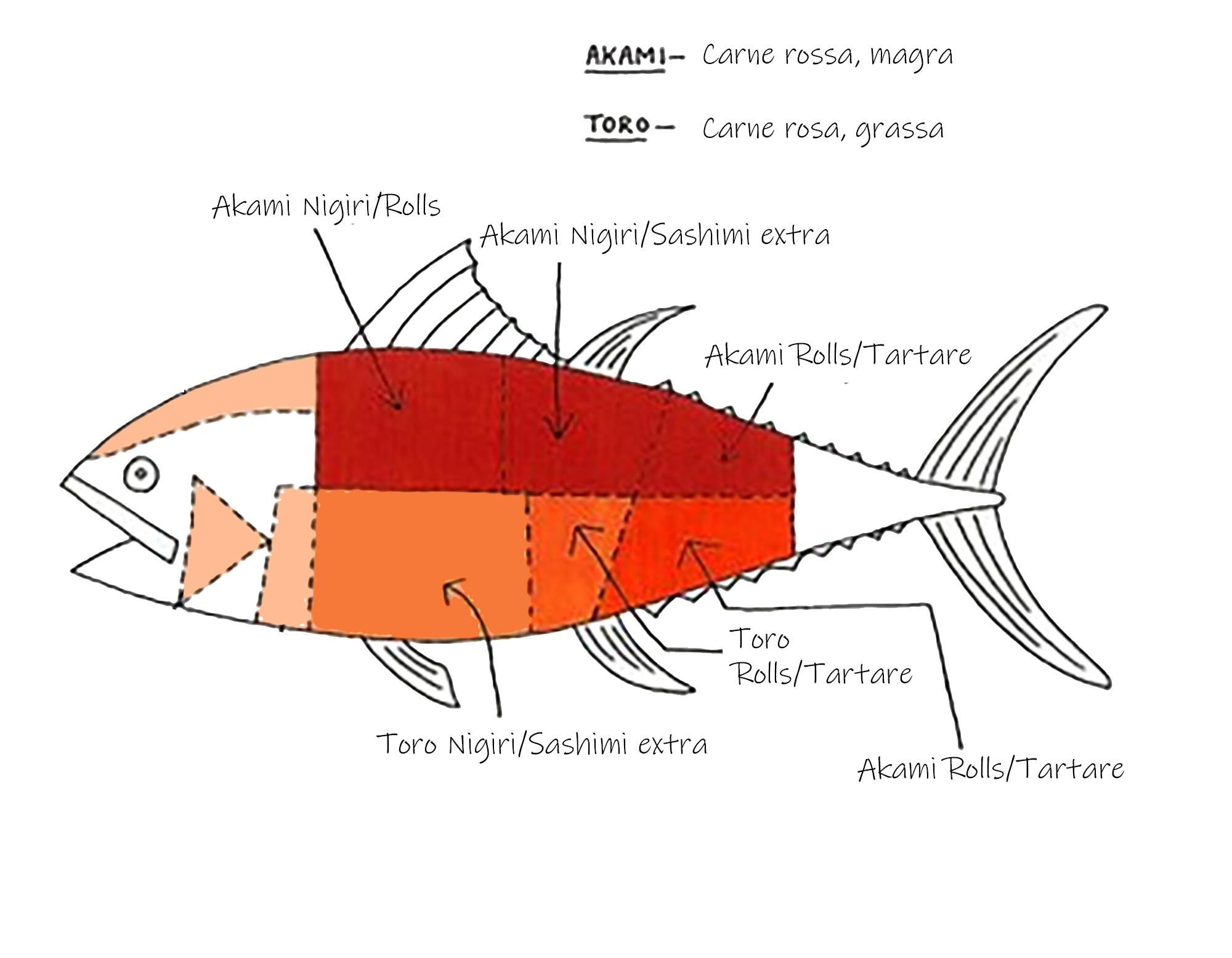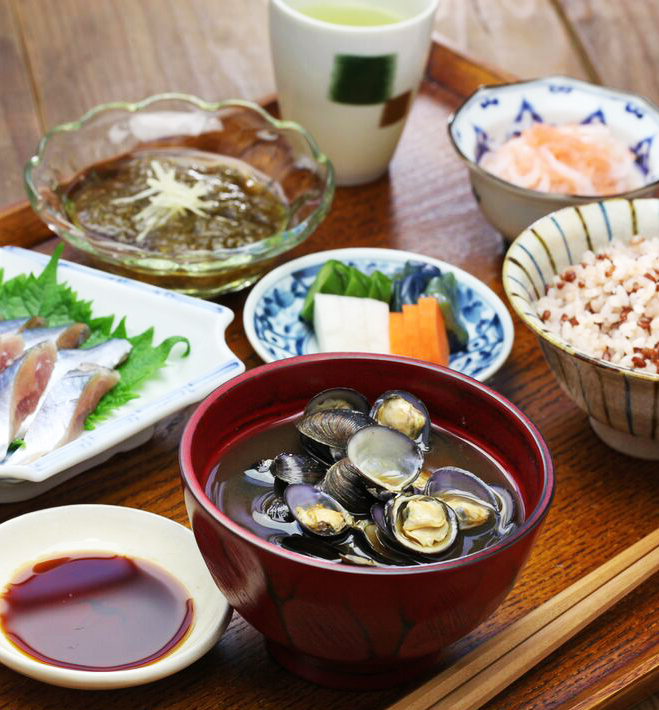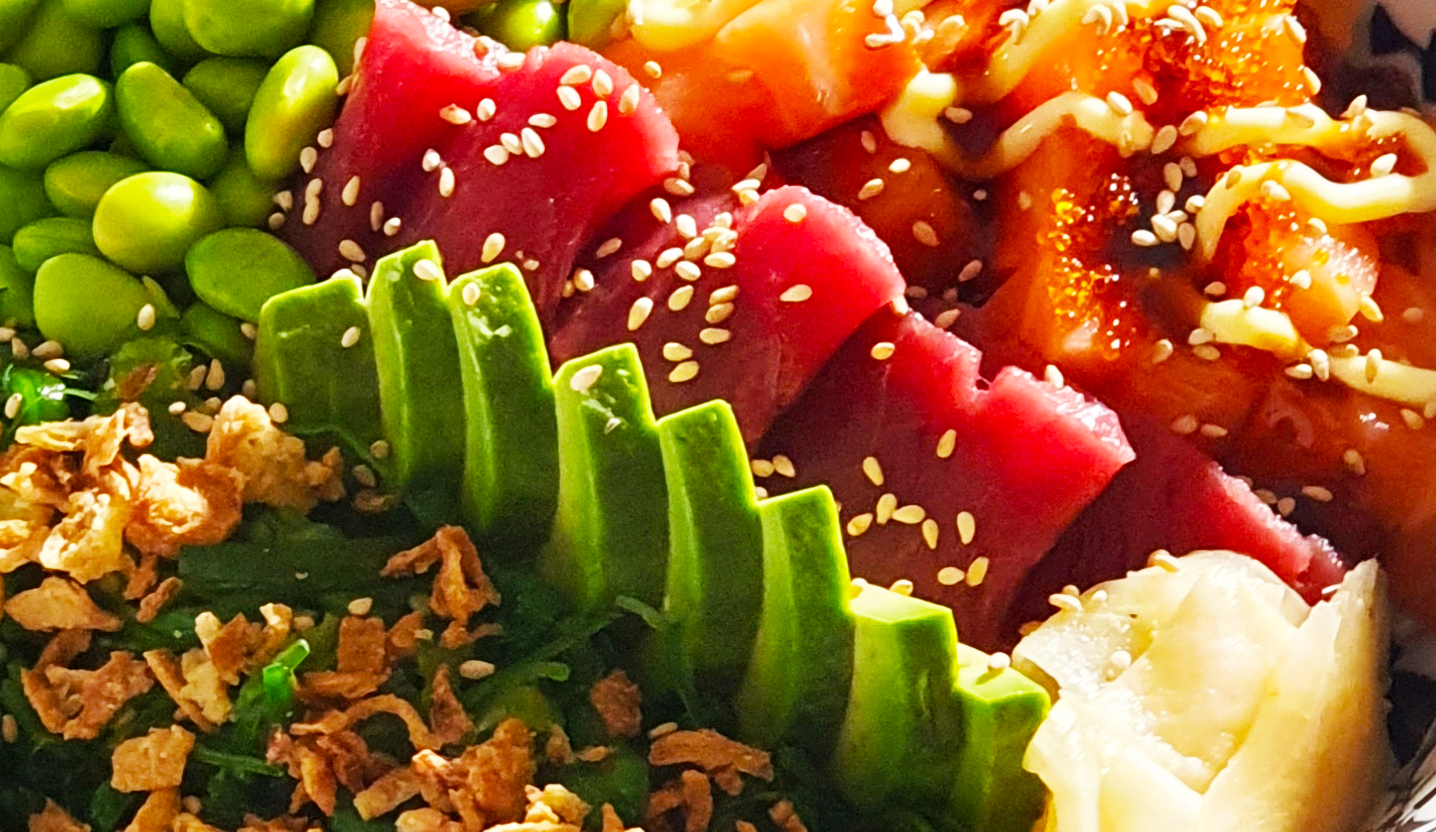Which tuna to choose for good sushi?
DESCRIPTION AND MORPHOLOGY
Bluefin tuna is a teleost fish of the family Scombridae, also known as bluefin or pinnablu tuna. Thynnus thunnus, is a large pelagic fish that can reach 3 meters in length and 700kg in weight, has a massive, fusiform, muscular and hydrodynamic body, a prominent snout with small side eyes. Scales are of various sizes, from large to very small, and distributed all over the body. They exhibit a dark steel blue color on the back, sometimes almost black, while on the belly and flanks they are silvery-white, even with lighter speckles in the part closest to the tail. It feeds on sardines, round sardinella and cephalopods.
DISTRIBUTION AND HABITAT
Bluefin tunas in their juvenile stage live in small groups and can reach depths of 500 m in some areas of the Mediterranean Sea or North Atlantic Ocean.
MIGRATION AND REPRODUCTION
Come spring, all the specimens that have reached sexual maturity group together in large shoals and give rise to a long migration that will take them across the Ocean until they enter the Mediterranean Sea, where they will give rise to reproduction. During the migration phase, the Bluefin Tuna is fat, well-fed, and the meat is well sprinkled, firm and compact, of great commercial value.
Between the end of April and the beginning of May, tunas head for major spawning grounds such as the coasts of North Africa, the Balearic Islands, Sicily, Sardinia and the Adriatic Sea. Generally, spawning takes place in mid- to late June when bluefin tuna approach the coast to lay millions of tiny eggs, which are immediately fertilized by the males, but the exertions of spawning and the hot summer waters cause the meat to spoil quickly, becoming flabby and gelatinous, thus losing all commercial value.
GROWTH
Meanwhile, fertilized eggs roam the sea, until the rapid hatching that will see millions of fry emerge. Growth is rapid, such that young tuna at the end of the summer will measure about 15 cm and weigh 40 to 100 grams; at one year old they will be about 70 centimeters long and can range from 3 to 5 kilograms. Between their second and fourth year of age, Bluefin Tuna will reach sexual maturity; just over a meter long and weighing no less than 15 kilograms, they are ready to leave the Mediterranean to face the “return” migration that will take them to the North Atlantic Ocean, through the Strait of Gibraltar.
FISH
The red, flavorful meat makes it a real treasure in the seafood industry, especially sought after by the Japanese to make sashimi and sushi. For this reason, it is pursued by numerous fishing techniques, both professional and recreational. Professional fishermen catch them using sedentary tuna traps, purse seines, longlines and harpoons.
NET FISHING
Net fishing is becoming less and less common, with Mediterranean fixed tuna traps in particular closing one after another following the decline in the Bluefin tuna stock in past years. The demand for tuna in Italy until 20 years ago was exclusive to the canning industry, which cooked it in oil for canning in cans or glass jars.
The Japanese market absorbed the best tuna, processed by specialized personnel sent to the tuna fisheries directly from Japan to control all stages from catching to shipping by air. The exponential growth in the number of Japanese restaurants during the past 15 years has transformed the market, giving greater weight to the demand for quality sashimi. This is why most of the fixed tuna traps have closed, because the net catch is massive and does not allow them to devote the care necessary to maintain good meat quality. Certainly very efficient because of the large quantities caught but low quality of the catch, thousands of tuna struggling in the nets cause the flesh to flake, accumulation of lactic acid, yake in Japanese, an acid that burns the flesh and causes it to lose commercial value.
PURSE SEINE FISHING
Stationary tuna traps have given way to purse seines or flying traps that feed caged tuna farming. Schools of tuna are spotted by small aircraft, approached by fishing boats, using bait to concentrate them into compact schools, while the fishing boat encircles the school with a ring net. When the herd has been surrounded, the bottom of the net is closed. The tuna become trapped inside a circular cage about 40 meters in diameter. From the fishing grounds, they are towed to Spanish or Maltese breeding facilities that fatten them up for months to offer them fatter and heavier to the Japanese market, which pays top dollar for them. Besides being expensive, farmed tuna becomes too fatty for the local market. The Japanese love full-fat tuna, even if it is pink, while the Italians love bright red tuna.
LONGLINE FISHING
The main fishing method for obtaining this quality is longline fishing or
Palamito, professional fishing gear consisting of a long, large-diameter line with inserted, at regular intervals, pieces of thinner line each carrying a hook. This fishery is more selective than the purse seine and allows for greater “care” of the fish in order to maintain the best quality of meat. The fishing and tuna care technique that ensures sashimi quality is called hikejime. The angling phases causes the fish to accumulate a high rate of stress, and when they finally reach the surface they have a buildup of lactic acid that can ruin the quality of the meat. Fish that are not “cured” often result in “burned” or in Japanese “Yake” and it happens if the tuna is immediately brought on board. For this reason, most fishermen who want to offer the superior quality tuna for sushi will tie the tuna along the side of the vessel to allow it to swim slowly until the lactic acid buildup is disposed of.
Tuna should be killed and not left to die in the water after slow agony, and being a warm-blooded fish, its blood should be prevented from pooling inside the body and tissues. In order to achieve sashimi quality, it is necessary to remove as much circulating blood from the fish as quickly as possible without it accumulating or clotting in the meat to prevent it from altering the taste by also increasing the amount of unwanted bacteria.
To perform this maneuver, it is necessary to make an incision just behind the pectoral fins that will sever the main cardiac artery, and place it to bleed for 10 to 15 minutes in a tub of seawater and ice.
The removal of the entrails is really simple, however, since the belly meat is the most valuable (Otoro), fishermen often make a circular incision in the anal region to pull the entrails out of the back of the fish without damaging the “belly”.
Once gutted, the high rate of stress accumulated by the tuna during the catching stage means that the meat may be too hot and can cause rapid spoilage.
It is essential that the meat be cooled as quickly as possible and kept at a temperature just above freezing until you want to eat or process the fish further. The best way to do this is to apply ice to both sides of the fish and fill the abdominal cavity with crushed ice, avoiding water contact with the exposed flesh to emasculate color loss.
Maintaining the cold chain will be critical to maintaining the color and sashimi quality of bluefin tuna.
That said, what is the best tuna to eat raw?
FISHING PERIOD
Another factor that determines quality is the fishing period. In fact, as we have said, once the spawning phase is over, around mid-July to mid-August, the tuna are tired and undernourished, the meat gelatinous and of little commercial value, worsened if possible also by the summer seawater temperatures. For this reason, during this period, boats from Palangaro stop tuna fishing to focus on swordfish fishing.
CONSERVATION OF THE SPECIES
Until 1999, the absence of regulations in professional fishing meant that fishing boats waited for large schools of tuna just outside the Strait of Gibraltar to follow and catch them with the help of drones and their efficient technological means. Intensive and unregulated exploitation of the Thynnus thunnus stock has put it at serious risk of extinction. The International Commission for the Conservation of Bluefin Tuna said in October 2009 that bluefin tuna stocks have declined dramatically over the past 40 years by about 82 percent compared to previous years. In early 2010, European officials, led by the French Minister of Ecology, increased pressure to ban commercial fishing of bluefin tuna internationally.
Today, in order to fish for Bluefin Tuna, it is necessary to have a license specifically dedicated to Bluefin Tuna fishing, which is extremely difficult to obtain and easy to be revoked. Each authorized boat is granted a fishing quota established and verified upon landing by port authorities. With each catch, the captains of the authorized boats must go to the Port Authority and register the amount of fish landed, and it will issue a BCD fishing certificate, an identification passport of that catch that will follow all stages of marketing to the final consumer. Any merchant who offers Bluefin Tuna on their fish counter or menu should be able to provide BCD upon consumer request.
Thanks to the quota and regulation of fishing quotas, Bluefin Tuna has become abundant again in our seas.
POACHING
If regulation was necessary to prevent the extinction of this valuable fish species, the mafias immediately smelled a space to enrich themselves. In fact, while the price per kilogram of Bluefin Tuna has risen considerably precisely in light of the many bureaucratic requirements, a parallel market of poached fish at significantly lower prices, but extremely dangerous to health, has taken hold. Vessels poaching tuna do not land in ports, but are met offshore by speedy spears or dinghies that drag the fish tied underboard with a line to a beach where underworlders will secretly load it onto trucks destined for all over the country. Poached tuna is a fish that has not maintained the cold chain and for this reason is at high risk of developing histamine, a substance that is highly toxic to human health. Sold to the restaurant industry at a much lower price, they risk intoxicating customers of greedy and unscrupulous restaurateurs.
ANISAKIS
Anisakis is a small parasitic worm most common in bluefish, herring and tuna. The characteristic feature of this parasite is its ability to survive in the acidic environment of the stomach. Therefore, once ingested by a sardine, the parasite sits quietly absorbing nutrients in its stomach. But if the fish dies, the worm thanks to an enzyme produced by its mouthparts is able to pierce the tissues to try to leave the dead fish that will no longer be useful to it for survival.
In this way, Anisakis is able to move from small fish to large fish throughout the food chain. If the worm gets into the tuna’s stomach, and the tuna is gutted as soon as it is caught as is the case with sashimi-quality fish, it does not have time to attempt escape. But if the tuna remains full with its innards, for days on end, the worm will have useful time to begin a migration that will lead it to penetrate the muscle tissues of the tuna, tissues that could end up in a nigiri or sushi roll. What happens if it is ingested by humans? If the worm is ingested dead, only in case of sensitivity of some individuals, it could bring an allergic reaction up to anaphylactic shock, while if the worm is ingested alive, the problem is far more serious. In fact, the Anisakis, being in an environment much more acidic than a fish’s stomach, will attempt escape by puncturing the stomach or intestines of the victim. The culling is precisely to kill the tiny parasite, which does not survive temperatures of -18°C for more than 24 hours.
Using downed fish when it is to be consumed raw is an absolute guarantee that you will never find the worm alive and eager to roam around our digestive tract looking for the exit.
How to choose good frozen tuna?
FROZEN TUNA
We mentioned that Tuna is a warm-blooded fish and the blood tends to oxidize and turn dark. We can cull and freeze a top-grade tuna, cured with all the best Japanese techniques, but if stored in the freezer at -18°C within a few days it will turn browner and browner to an unattractive color. So how can bluefin tuna be preserved? The only technique is DEEP FROZEN, a rapid chilling with a temperature as low as -60°C, which allows the complex organoleptic characteristics of Bluefin Tuna to be sealed for up to 8-9 months. In fact, at this temperature, tissues retain their organoleptic characteristics and do not oxidize. For this reason, all frozen tuna destined for Japan is nitrogen blasted and shipped in special containers that can maintain the temperature at -60°C. However, who has a -60°C freezer at the restaurant or worse, at home? Obviously very few, in fact very few! The secret lies in buying DEEP FROZEN Tuna and storing it in the freezer at -18°C for never more than 7 days.
Once thawed, DEEP FROZEN or SUPERFROZEN TUNA will return even as fresh, the deep red color we are used to imagining when it comes to this giant of our seas.
WHAT CUTS OF TUNA FOR SUSHI?
Want to make sushi and don’t know which part of the tuna is best? Well then, it’s time to study some anatomy.
Tuna consists of 4 strands, 2 dorsal and 2 ventral. In the 2 ventrals, the ventrescae and belly are present. Each part has its own peculiarity and fits a certain type of workmanship.
For nigiri and sashimi you need lean, firm meat without connective membranes and with a nice bright red color. These features are present in two-thirds of the dorsal threads, excluding the part closest to the tail crossed by tendons that are responsible for moving the powerful propulsion. This end of the fillets is generally beaten, cleaned of tendons and used in tartare and spicy tuna. The ventral fillet, contains the most valuable and fatty parts of the fish, the belly or in Japanese Otoro. This part is pink streaked with white, buttery, flavorful, and fragrant, and is used for Otoro’s best sashimi and nigiri, the true king’s bite. The Akami part of ventral fillet can be used two-thirds for rolls and one-third tail for tartare.




